History of the Bible - Lesson 11
Protestant Reformation and the Bible
History of the Bible Lesson 11
The Protestant Reformation and the Bible
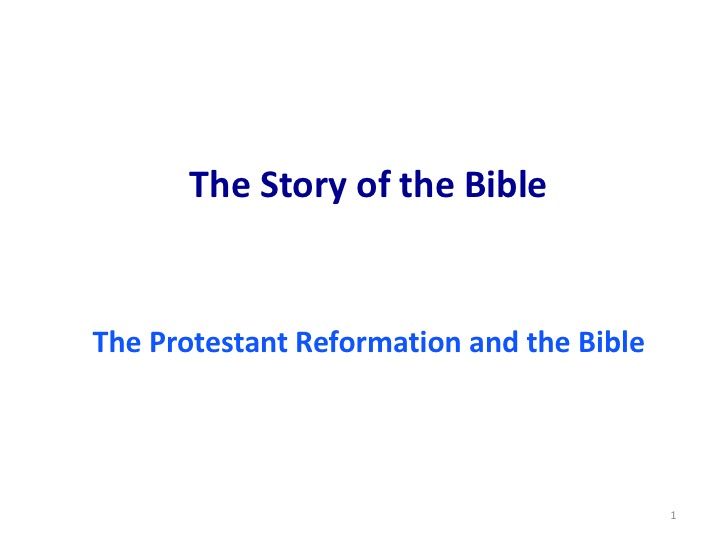
The Story of the Bible so far has not lacked drama. But it is about to get more dramatic.
If the Renaissance and the printing press gave Europe a new appreciation of the past, a thirst for change, and a broader understanding of what was in the Bible, the Protestant Reformation of the 16th century used the Bible to challenge the medieval Catholic understanding by a deeper appeal to the past and in doing so changed the world. In fact it created a new Europe.
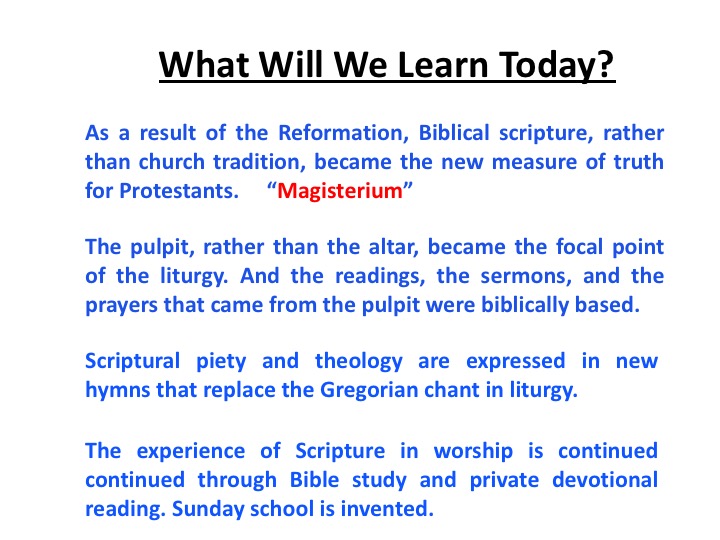
What Will We Learn Today?
As a result of the Reformation, Biblical scripture, rather than church tradition, became the new measure of truth for Protestants. “Magisterium” - A new word for today - the Catholic Church term for the church tradition is often called the Magisterium. It means the official teachings of the church as determined by the Pope and his top Bishops. Rather than "sola scriptura" as demanded by the reformers, it held that yes - scripture is important, but it is scripture as interpreted by the Magisterium, not by anyone else. The Magisterium came under direct attack by the reformers.
The pulpit, rather than the altar, became the focal point of the liturgy for the reformers. And the readings, the sermons, and the prayers that came from the pulpit were biblically based.
Scriptural piety and theology are expressed in new hymns that replace the Gregorian (Latin) chant in liturgy. And these hymns of the reformers were in the language of the people and were biblically based.
The experience of Scripture in worship is continued continued through Bible study and private devotional reading. Sunday school is invented.
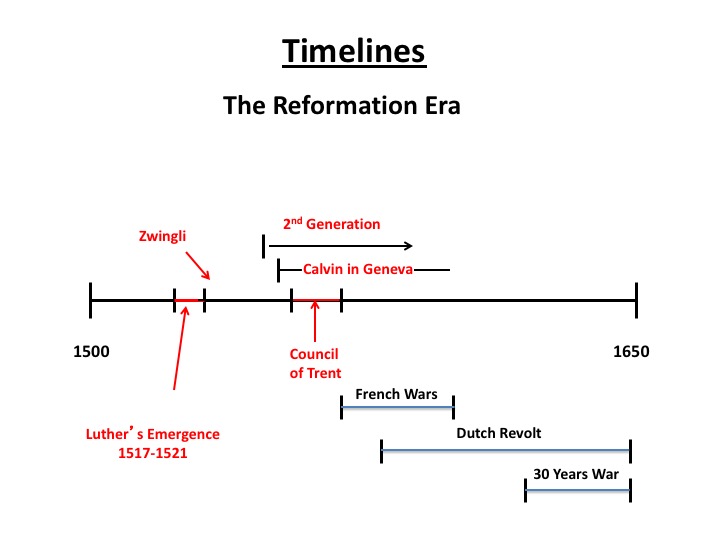
But before we get focused on the Reformation and the bible, it may help to give a very brief review of Reformation history and what eventually came out of it.
The "official" time line of the Reformation covered about 150 years from 1500 to 1650. Luther's famous posting of his 95 theses on the door of the Wittenberg church happened in 1517. We will talk about that in another 3 slides.
Luther, in Germany, and Zwingli in Switzerland, are normally considered to be part of the first generation of reformers. There were many others and in fact there had been potential reformers that preceded this first generation by 200 or more years. But they were not successful.
The second generation of reformers was the one led by John Calvin in Geneva after he had escaped from France. During that 2nd generation the Catholic church held the Council of Trent (1545-1563). This was prompted by the Protestant Reformation and eventually led to the Counter-Reformation - the Catholic response to the reformers. The Council was not continuous, convening and re-convening multiple times, but finally spending almost 4 years in conference.
The major wars of the Reformation era began after the Council of Trent and represent some of Christianity's darkest history. The French wars of religion went on for more than 25 years, the Dutch Revolt, in which the Spanish government tried to eliminate Protestants in the Dutch Republic went on intermittently for almost 80 years, and finally the very bloody 30 years War, fought mostly on German lands.
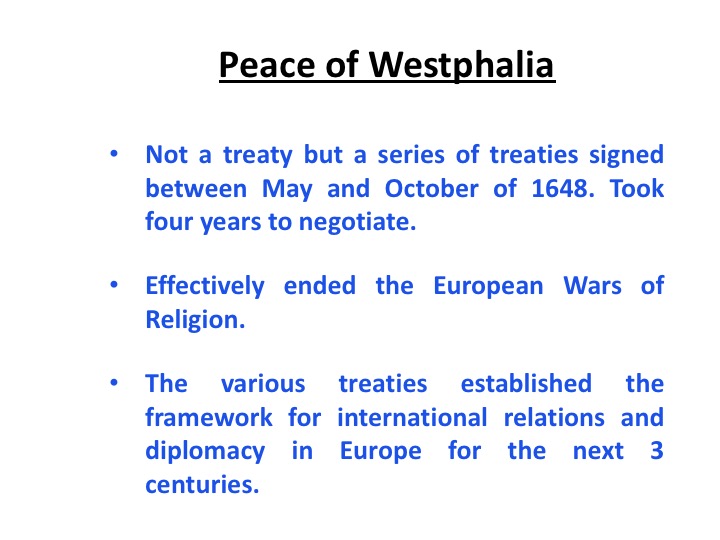
So what finally settled all of this.
The Peace of Westphalia was a series of peace treaties signed between May and October 1648 in the Westphalian cities of Osnabrück and Münster, effectively ending the European wars of religion. These treaties ended the Thirty Years' War (1618–1648) in the Holy Roman Empire, and the Eighty Years' War (1568–1648) between Spain and the Dutch Republic, with Spain formally recognizing the independence of the Dutch Republic.
The Peace of Westphalia was actually a single document summarizing in over 100 paragraphs all that was agreed to.
The Peace of Westphalia did not involve any major territorial losses or gains. However, it entailed the Spanish conceding that they could never recapture the United Provinces, the Hapsburgs acknowledging that they would never be absolute rulers over a unified Germany, and Catholic admission that Protestantism was here to stay. The recognition of these obvious facts of life was very important to future peace and stability in Europe.
But let us not forget what led to this complex peace process. It was the total revulsion of everyone in Europe to the mass killing of the religious wars between Christians.
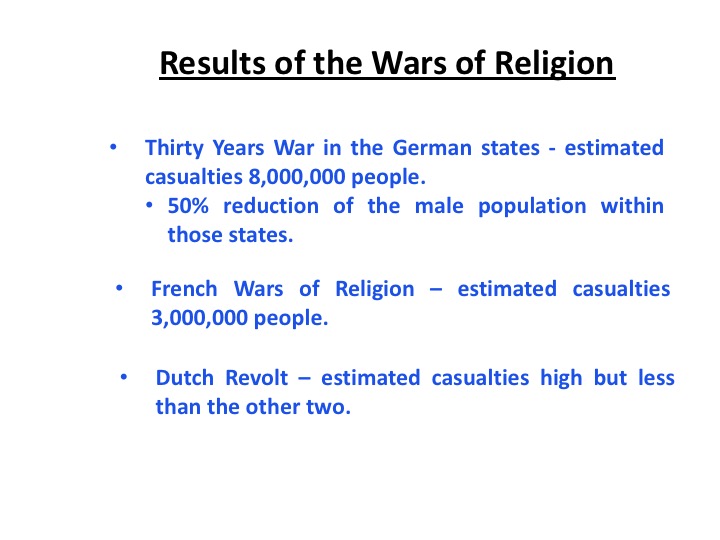
Results of the Wars of Religion
Thirty Years War in the German states - estimated causalities 8,000,000 people.
- 50% reduction of the male population within those states.
French Wars of Religion – estimated causalities 3,000,000 people.
Dutch Revolt– estimated causalities high but less than the other two.
And with that brief review of a long and complex Reformation Era let us now turn to the Bible and the Reformation.
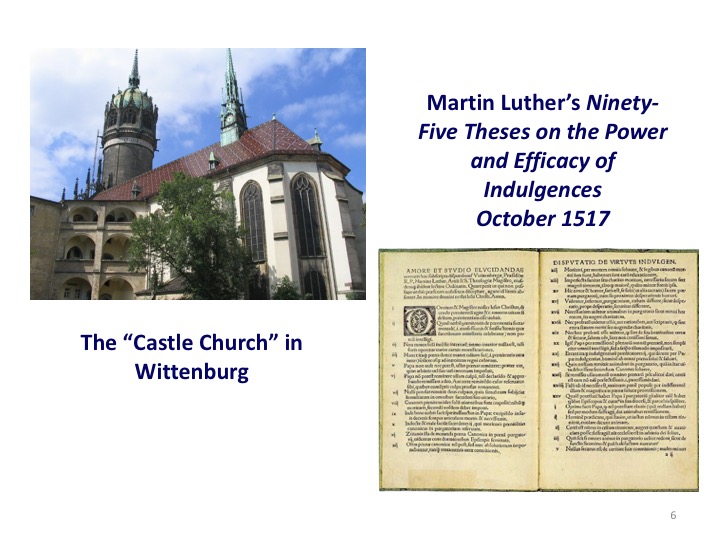
Martin Luther’s Ninety-Five Theses on the Power and Efficacy of Indulgences
October 1517
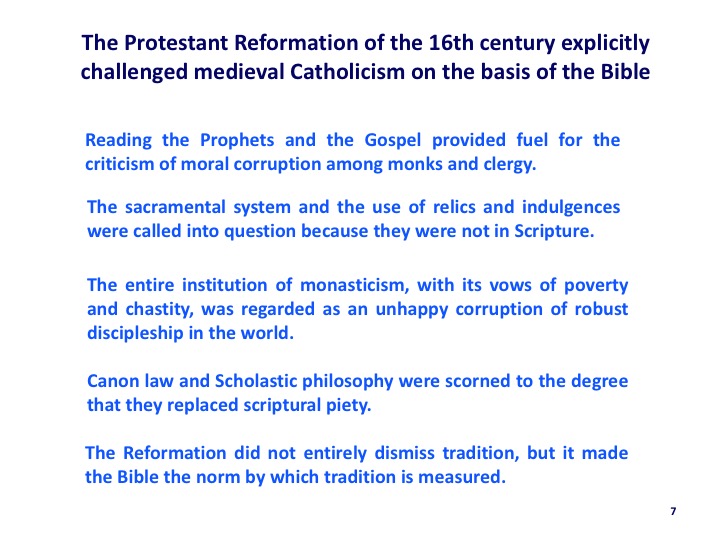
The Protestant Reformation of the 16th century explicitly challenged medieval Catholicism on the basis of the Bible
The first important criticism was in the moral realm. As the reformers read the prophets call for a return to God and read the Gospels call for a simpler moral life they turned their attention to the growing corruption of Catholicism of the late middle ages, with high living bishops in ornate living arrangements. They saw clergy at all levels who claimed to practice celibacy, but in fact openly practiced concubinage. And in place of the formally very poor monastery life they now saw the property rich monastery's. And they asked the basic question – where is the simple life of faith?
As a reminder – in the medieval Catholic system if you created a mortal sin and were not forgiven before death then you went straight to hell. If you were forgiven of sins then you went to heaven. But if you created not a mortal sin but what they called a venial sin – in other words not murder or adultery but chewing gum in church – then what happened. There had to be some form of punishment for not being perfect. The Catholic system had evolved the notion of purgatory – a place where you had to spend some time working off your sins before joining the life of God.
Since the thought of spending time in purgatory had no appeal the then a bevy of work out procedures had developed to minimize your time in purgatory.
Two of the workout procedures were the use of relics and indulgences. By doing good deeds you could reduce your time in purgatory. One good deed was to go and gaze on and adore relics of Christianity. The church in Wittenberg where Martin Luther posted his 95 thesis that is often considered the opening salvo of the Reformation housed a huge collection of relics.
By 1518 Frederick's (Elector of Saxony) castle church contained 17,443 holy relics, including a piece of Moses' burning bush, parts of the holy cradle and swaddling clothes, thirty-five fragments of the true cross, and the Virgin Mary's milk. A diligent and pious person who rendered appropriate devotion to each of these relics could earn exactly 127,799 years and 116 days of remission from purgatory. Indulgences started out as any good deed – taking care of the poor – going on pilgrimage (to see relics of course) – donating to a monastery, etc. But by Luther’s time you no longer had to do the good deed – you could just purchase the indulgence. It was sort of like a mail order college diploma.
As you are probably aware – none of this is in scripture - but now it had become much more evident to more people that it was not in scripture – and the reformers seized on this. Relics and indulgences were in fact a target rich environment for reformers. And the Catholic hierarchy had very little rebuttal.
Monasticism – early monasticism (fuggy mundi) was an authentic attempt to leave material enticements in order to live a truly spiritual life. But by the high middle ages the property rich monasteries were increasingly regarded as an easy escape form an authentic life of citizenship in the world. Life in medieval Europe was a very hard life of manual labor – but not so much in the monasteries – where the food was good and the work was considered easy. Monasticism came under heavy attack – and again – it was not in scripture.
The Reformers also turned hard on the complex and difficult to understand examination of theology that developed in the medieval Catholic Universities under the general name called Scholastic Philosophy. They referred to this type of work as “Logic Chopping”. Luther was trained in this but came to reject it.
Bascially the Reformation thinkers turned the arguments upside down – the Bible was not to be interpreted inside of a man made tradition – but the Bible should define tradition.
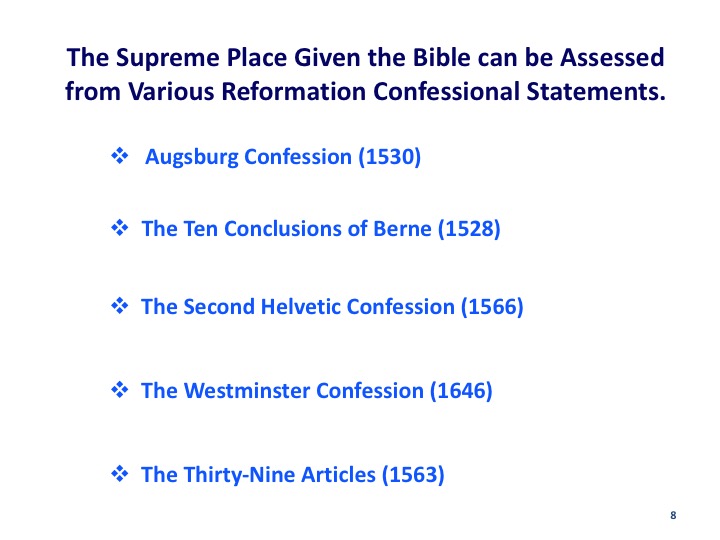
The Supreme Place Given the Bible can be Assessed from Various Reformation Confessional Statements.
Augsburg Confession (1530)
The Ten Conclusions of Berne (1528)
The Second Helvetic Confession (1566)
The Westminster Confession (1646)
The Thirty-Nine Articles (1563)
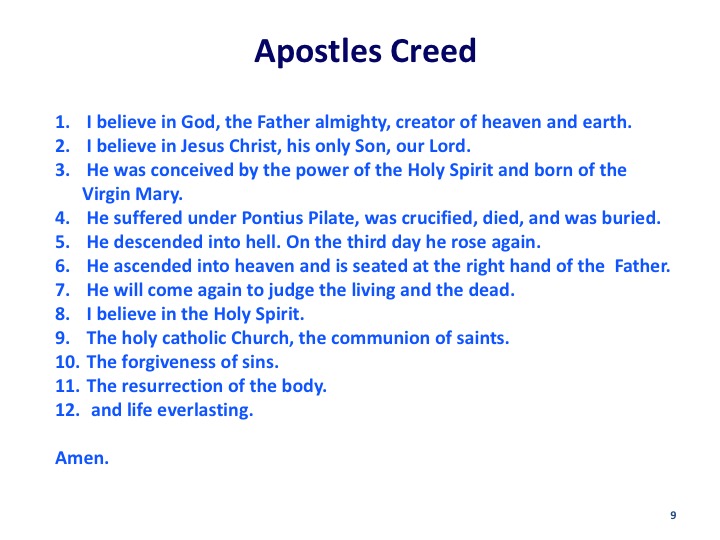
Apostles Creed
These confessions were much more than creedal statements, although many of them did include creeds, like the Apostles Creed.
Rather they were larger statements emphasizing the linkages of biblical scripture to reformers doctrines. Let's look at some examples.
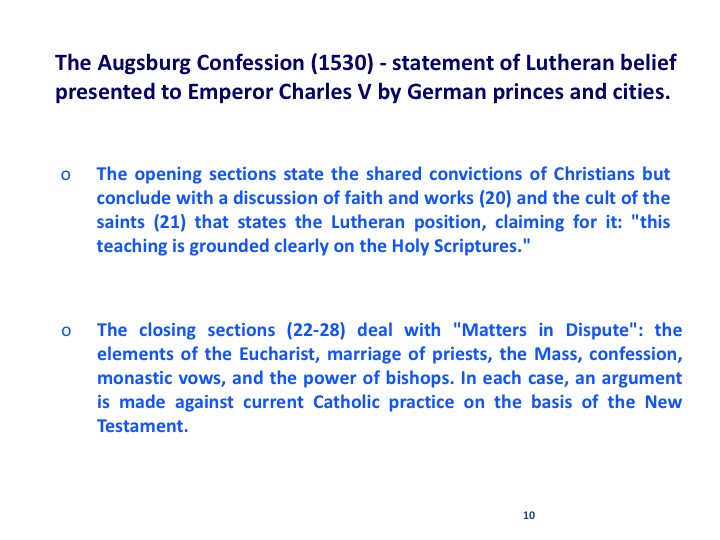
The Augsburg Confession (1530) - statement of Lutheran belief presented to Emperor Charles V by German princes and cities.
The opening sections state the shared convictions of Christians but conclude with a discussion of faith and works (20) and the cult of the saints (21) that states the Lutheran position, claiming for it: "this teaching is grounded clearly on the Holy Scriptures."
The closing sections (22-28) deal with "Matters in Dispute": the elements of the Eucharist, marriage of priests, the Mass, confession, monastic vows, and the power of bishops. In each case, an argument is made against current Catholic practice on the basis of the New Testament.
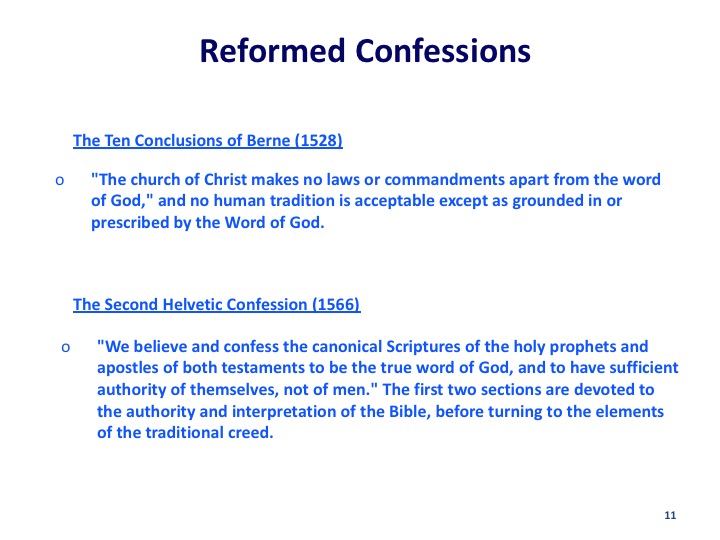
Reformed Confessions
The Ten Conclusions of Berne (1528)
"The church of Christ makes no laws or commandments apart from the word of God," and no human tradition is acceptable except as grounded in or prescribed by the Word of God.
The Second Helvetic Confession (1566)
"We believe and confess the canonical Scriptures of the holy prophets and apostles of both testaments to be the true word of God, and to have sufficient authority of themselves, not of men." The first two sections are devoted to the authority and interpretation of the Bible, before turning to the elements of the traditional creed.
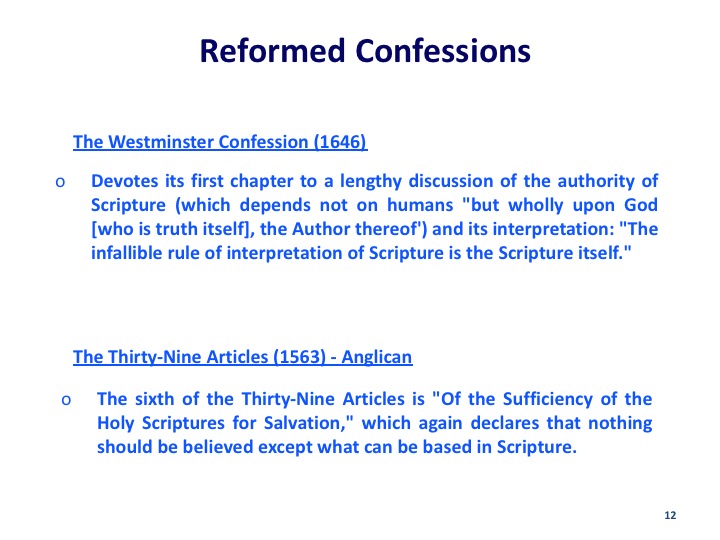
Reformed Confessions
The Westminster Confession (1646)
Devotes its first chapter to a lengthy discussion of the authority of Scripture (which depends not on humans "but wholly upon God [who is truth itself], the Author thereof') and its interpretation: "The infallible rule of interpretation of Scripture is the Scripture itself."
The Thirty-Nine Articles (1563) - Anglican
The sixth of the Thirty-Nine Articles is "Of the Sufficiency of the Holy Scriptures for Salvation," which again declares that nothing should be believed except what can be based in Scripture.
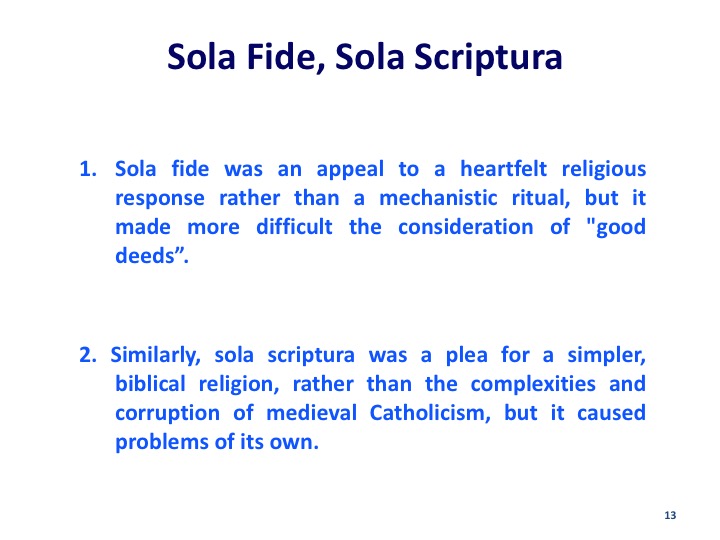
Sola Fide, Sola Scriptura
1. Sola fide was an appeal to a heartfelt religious response rather than a mechanistic ritual, but it made more difficult the consideration of "good deeds”.
2. Similarly, sola scriptura was a plea for a simpler, biblical religion, rather than the complexities and corruption of medieval Catholicism, but it caused problems of its own.
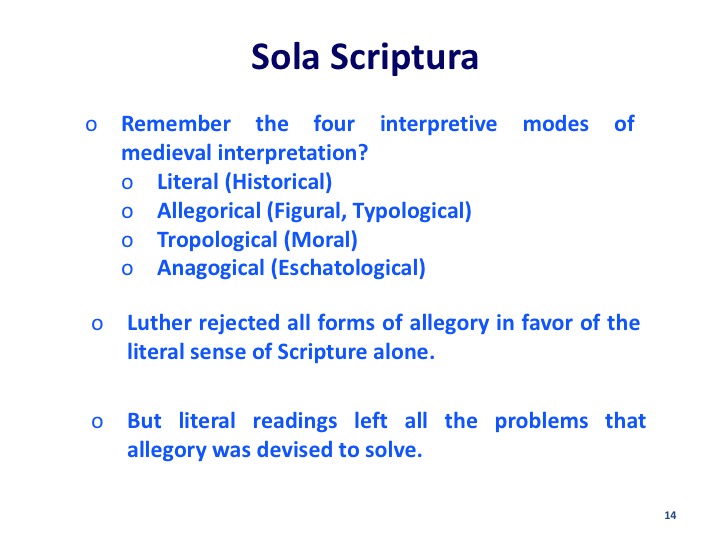
Sola Scriptura
o Remember the four interpretive modes of medieval interpretation?
o Literal (Historical)
o Allegorical (Figural, Typological)
o Tropological (Moral)
o Anagogical (Eschatological)
o Luther rejected all forms of allegory in favor of the literal sense of Scripture alone.
o But literal readings left all the problems that allegory was devised to solve.
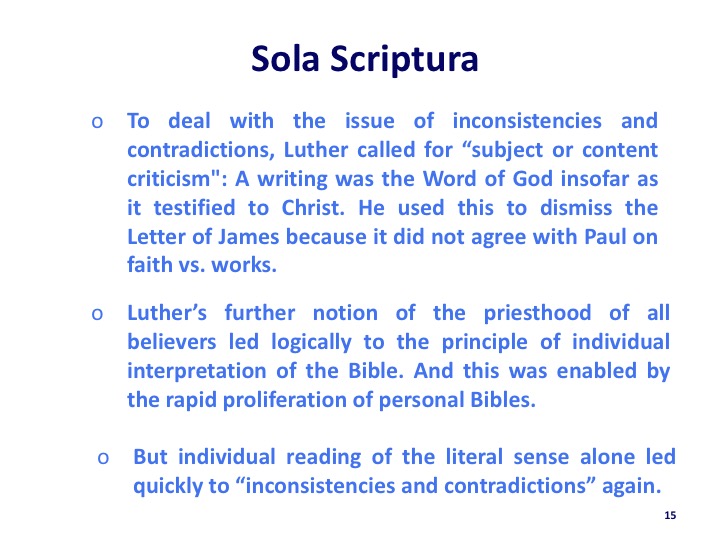
Sola Scriptura
To deal with the issue of inconsistencies and contradictions, Luther called for sachcratik (”subject criticism"):
A writing was the Word of God insofar as it testified to Christ.
On this basis, Luther dismissed the Letter of James because it did not agree with Paul on faith and works.
But content criticism directly conflicts with the notion of "Scripture alone" as adequate norm.
Luther’s further notion of the priesthood of all believers led logically to the principle of individual interpretation of the Bible. And this was enabled by the rapid proliferation of personal Bibles.
But individual reading of the literal sense alone led quickly to “inconsistencies and contradictions” again.
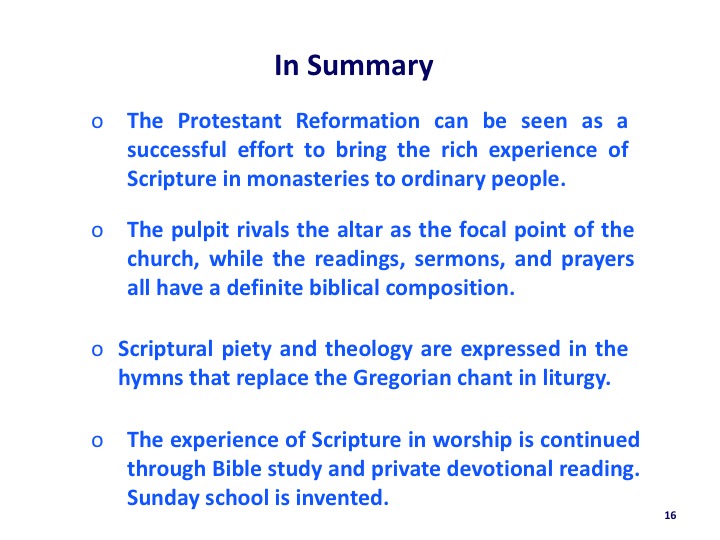
In Summary
The Protestant Reformation can be seen as a successful effort to bring the rich experience of Scripture in monasteries to ordinary people.
The pulpit rivals the altar as the focal point of the church, while the readings, sermons, and prayers all have a definite biblical composition.
Scriptural piety and theology are expressed in the hymns that replace the Gregorian chant in liturgy.
The experience of Scripture in worship is continued through Bible study and private devotional reading. Sunday school is invented.
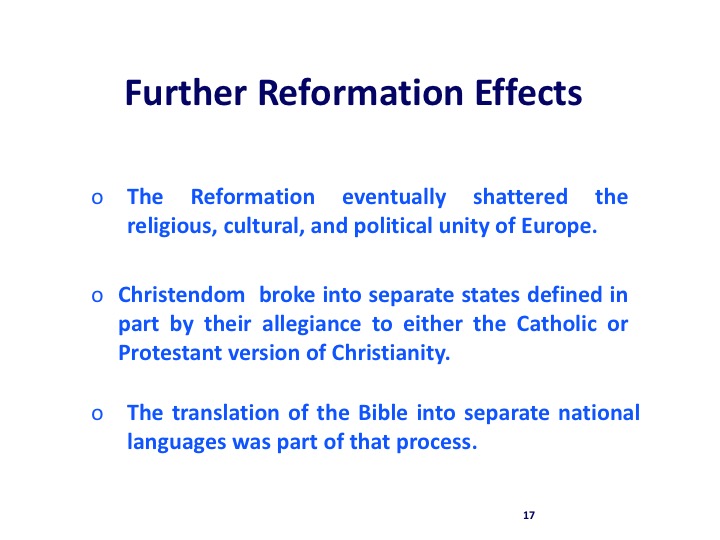
Further Reformation Effects
The Reformation eventually shattered the religious, cultural, and political unity of Europe.
Christendom broke into separate states defined in part by their allegiance to either the Catholic or Protestant version of Christianity.
The translation of the Bible into separate national languages was part of that process.
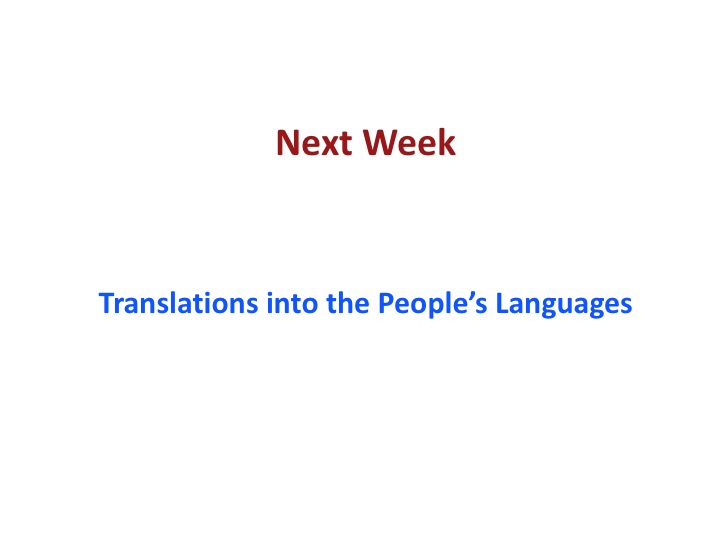
Next Week
Translations into the People’s Languages